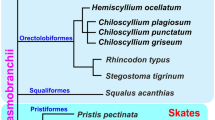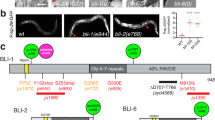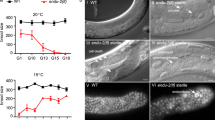Abstract
The molecular controls governing organ shape are poorly understood. In the nematode Caenorhabditis elegans, the gonad acquires a U-shape by the directed migration of a specialized ‘leader’ cell, which is located at the tip of the growing gonadal ‘arm’1. The gon-1 gene is essential for gonadal morphogenesis: ingon-1 mutants, no arm elongation occurs and somatic gonadal structures are severely malformed2. Here we report that gon-1 encodes a secreted protein with a metalloprotease domain and multiple thrombospondin type-1-like repeats. This motif architecture is typical of a small family of genes that include bovine procollagen I N-protease (P1NP), which cleaves collagen3, and murine ADAMTS-1, the expression of which correlates with tumour cell progression4. We find that gon-1 is expressed in two sites, leader cells and muscle, and that expression in each site has a unique role in forming the gonad. We speculate that GON-1 controls morphogenesis by remodelling basement membranes and that regulation of its activity is crucial for achieving organ shape.
This is a preview of subscription content, access via your institution
Access options
Subscribe to this journal
Receive 51 print issues and online access
$199.00 per year
only $3.90 per issue
Buy this article
- Purchase on Springer Link
- Instant access to full article PDF
Prices may be subject to local taxes which are calculated during checkout




Similar content being viewed by others
References
Kimble, J. E. & White, J. G. On the control of germ cell development in Caenorhabditis elegans. Dev. Biol. 81, 208–219 (1981).
Blelloch, R., Santa Anna-Arriola, S., Li, Y., Hodgkin, J. & Kimble, J. The gon-1 gene regulates morphogenesis of the C. elegans gonad (submitted).
Colige, A. et al. cDNA cloning and expression of bovine procollagen I N-proteinase: a new member of the superfamily of zinc-metalloproteinases with binding sites for cells and other matrix components. Proc. Natl Acad. Sci. USA 94, 2374–2379 ( 1997).
Kuno, K. et al. Molecular cloning of a gene encoding a new type of metalloproteinase-disintegrin family protein with thrombospondin motifs as an inflammation associated gene. J. Biol. Chem. 272, 556– 562 (1997).
Rawlings, N. D. & Barrett, A. J. Evolutionary families of metallopeptidases. Methods Enzymol. 248 , 183–228 (1995).
Pei, D. & Weiss, S. J. Furin-dependent intracellular activation of the human stromelysin-3 zymogen. Nature 375, 244–247 (1995).
Pei, D. & Weiss, S. J. Transmembrane-deletion mutants of the membrane-type matrix metalloproteinase-1 process progelatinase A and express intrinsic matrix-degrading activity. J. Biol. Chem. 271, 9135–9140 (1996).
Stöcker, W. et al . The metzincins—topological and sequential relations between the astacins, adamalysins, serralysins, and matrixins (collagenases) define a superfamily of zinc-peptidases. Protein Sci. 4, 823–840 (1995).
Cha, J. & Auld, D. S. Site-directed mutagenesis of the active site glutamate in human matrilysin: investigation of its role in catalysis. Biochemistry 36, 16019– 16024 (1997).
Will, H., Atkinson, S. J., Butler, G. S., Smith, B. & Murphy, G. The soluble catalytic domain of membrane type 1 matrix metalloproteinase cleaves the propeptide of progelatinase A and initiates autoproteolytic activation. J. Biol. Chem. 271, 17119–17123 (1996).
Adams, J. C., Tucker, P. R. & Lawler, J. The Thrombospondin Gene Family (Landes, Austin, Texas, (1995).
Anderson, P. & Kimble, J. in C. elegansII (eds Riddle, D. L., Blumenthal, T., Meyer, B. J. & Priess, J.R.) 185– 208 (Cold Spring Harbor Laboratory Press, (1997).
Henderson, S. T., Gao, D., Lambie, E. J. & Kimble, J. lag-2 may encode a signaling ligand for the GLP-1 and LIN-12 receptors of C. elegans . Development 120, 2913– 2924 (1994).
Okkema, P. G., Harrison, S. W., Plunger, V., Aryana, A. & Fire, A. Sequence requirements for myosin gene expression and regulation in Caenorhabditis elegans. Genetics 135, 385–404 ( 1993).
Colige, A. et al. Characterization and partial amino acid sequencing of a 107-kDa procollagen I N -proteinase purified by affinity chromatography on immobilized type XIV collagen. J. Biol. Chem. 270, 16724–16730 (1995).
Lelongt, B., Trugnan, G., Murphy, G. & Ronco, P. M. Matrix metalloproteinases MMP2 and MMP9 are produced in early stages of kidney morphogenesis but only MMP9 is required for renal organogenesis in vitro. J. Cell Biol. 136, 1363–1373 ( 1997).
Hiraoka, N., Allen, E., Apel, I. J., Gyetko, M. R. & Weiss, S. J. Matrix metalloproteinases regulate neovascularization by acting as pericellular fibrinolysins. Cell 95, 365–377 (1998).
Korswagen, H. C., Durbin, R. M., Smits, M. T. & lasterk, R. H. A. Transposon Tc1-derived, sequence-tagged sites in Caenorhabditis elegans as markers for gene mapping. Proc. Natl Acad. Sci. USA 93, 14680–14685 (1996).
Mello, C. & Fire, A. in Caenorhabditis elegans: Modern Biological Analysis of an Organism (eds Epstein, H. F. & Shakes, D. C.) 451–482 (Academic, New York, (1995 ).
Fire, A. et al. Potent and specific genetic interference by double-stranded RNA in Caenorhabditis elegans. Nature 391, 806–811 (1998).
Williams, B. D., Schrank, B., Huynh, C., Shownkeen, R. & Waterston, R. H. Agenetic mapping system in Caenorhabditis elegans based on polymorphic sequence-tagged sites. Genetics 131, 609–624 (1992).
Krause, M. in Caenorhabditis elegans: Modern Biological Analysis of an Organism (eds Epstein, H. F. & Shakes, D. C.) 513–533 (Academic, New York, (1995).
Schedl, T. in C. elegansII (eds Riddle, D. L., Blumenthal, T., Meyer, B. J. & Priess, J. R.) 241–269 (Cold Spring Harbor Laboratory Press, (1997).
The C. elegans Sequencing Consortium. Genome sequence of the nematode C. elegans : a platform for investigating biology. Science 282, 2012– 2018 (1998).
Acknowledgements
We thank A. Coulson for providing cosmids, R. Barstead and A. Puoti for cDNA libraries, A. Fire for GFP and expression vectors, D. Gao for lag-2 promoter, J. Nance for Tc1 primers, theCaenorhabditis Genetics Center for worm strains, and the many lab members who provided thoughts and criticisms during the course of this work. R.B. is an MD/PhD student and was an NIH Molecular Biosciences trainee. J.K. is an investigator with the Howard Hughes Medical Institute and has been supported by grants from NIH and NSF.
Author information
Authors and Affiliations
Corresponding author
Rights and permissions
About this article
Cite this article
Blelloch, R., Kimble, J. Control of organ shape by a secreted metalloprotease in the nematode Caenorhabditis elegans. Nature 399, 586–590 (1999). https://doi.org/10.1038/21196
Received:
Accepted:
Issue Date:
DOI: https://doi.org/10.1038/21196
This article is cited by
-
Delay in primordial germ cell migration in adamts9 knockout zebrafish
Scientific Reports (2021)
-
mRNA profiling reveals significant transcriptional differences between a multipotent progenitor and its differentiated sister
BMC Genomics (2019)
-
Secreted metalloproteases ADAMTS9 and ADAMTS20 have a non-canonical role in ciliary vesicle growth during ciliogenesis
Nature Communications (2019)
-
Non-apoptotic cell death in animal development
Cell Death & Differentiation (2017)
-
An analysis of the transcriptome of Teladorsagia circumcincta: its biological and biotechnological implications
BMC Genomics (2012)
Comments
By submitting a comment you agree to abide by our Terms and Community Guidelines. If you find something abusive or that does not comply with our terms or guidelines please flag it as inappropriate.



